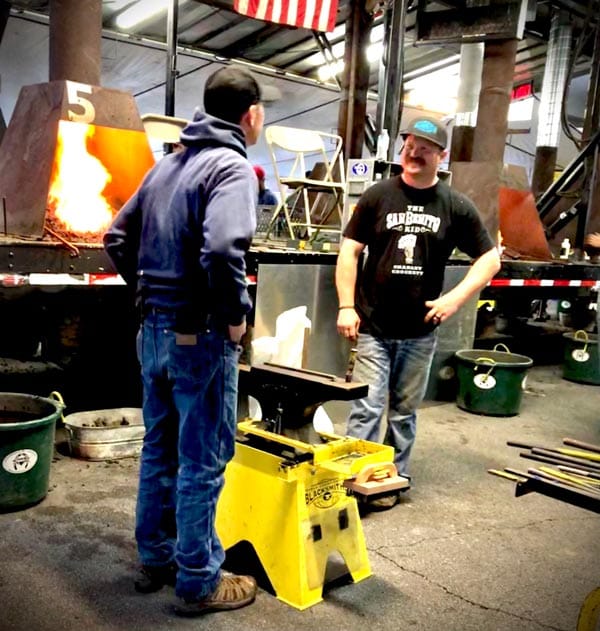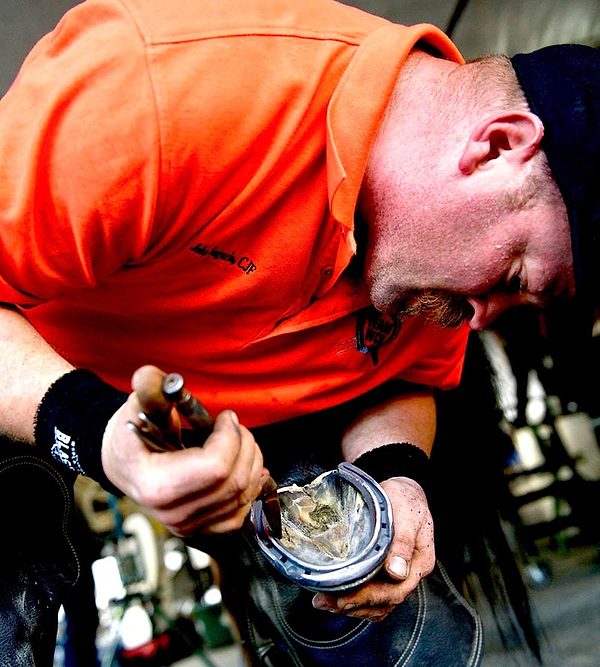Deciding the winner of the American Farriers Journal Most Improved Award in a World Championship Blacksmiths season isn’t always a straightforward process. While a noticeable increase in contest points is an important factor, it is also based on a farrier’s continued dedication to the craft, self-improvement and comradery.
“We look at who has steadily improved throughout the year with the points standing,” says World Championship Blacksmiths President and International Horseshoeing Hall of Famer Craig Trnka. “They may have slid backwards on a contest, but for the most part have improved their overall placings progressively over the season. There can be ties, so the WCB owners look at personal growth and dedication towards others as well. It’s a tough decision because there are usually several in the running, and you want them all to win it.”
John Sagaria, the 2019 recipient of the award, talks about his development as a farrier and the ways he has improved at the forge.
Q: Tell us a little about yourself and how you got started shoeing?
A: I’m from Petaluma, Calif., and I’m a second-generation farrier who has been shoeing horses for almost 20 years. After I graduated high school in 2000, my dad came to me and said, “All of your friends are going to college or trade school and I need help at work. Even if you don’t shoe horses for the rest of your life, at least you will be learning something.” Unbeknownst to him or me at the time, it was the best advice I had ever been given.
Q: What disciplines do you work with?
A: I shoe a variety of horses and disciplines in Sonoma and Marin counties here in California. I enjoy shoeing a little bit of everything. I shoe a handful of barrel horses, some dressage horses, about a dozen hunter jumpers, a few endurance horses, every day trail horses, and a few of what we like to call backyard performance horses. I’ve never really pigeon-holed myself into shoeing a certain discipline. If they stand good, and the owner is willing to pay, I am just as happy shoeing horses tied to a stock trailer as I am shoeing horses in a fancy show barn.
Q: How have your forging skills improved between this competition and the last?
A: I don’t know that my forging skills have drastically improved, but I think that my time management skills and getting everything done as correctly and efficiently as possible has. I learn something in every contest, but lately I have been realizing that it is more of a points game. For example, most competitors could get really good trim scores if they had all of the time they needed to trim the foot, but sometimes you might need to settle for an 8 or an 8.2 on your hoof prep to give yourself more time at the end to get your shoe fit, finished and nailed on well, rather than taking the time to get a 9 on your hoof prep. Then you’re rushing to get your shoe fit and turned in with time to finish.

Q: In what areas did you struggle and what was your ultimate goal?
A: I struggled a bit with making shoes that looked like the specimens. I also had a few other hiccups along the way, such as nail placement on a couple of shoes and a messed-up bob punch on one of my clips. My goal is to limit the easy mistakes and to not give the judges obvious things to pick apart on my shoes. I also need to study and look at the specimens more and try to mimic them more accurately.
Q: What steps did you take to improve?
A: I knew I needed to work on my time management, so I pushed myself to be more methodical in my shoe making and on my hoof prep. I just really tried to focus on only the job that was being asked of me.
Q: How did you prepare for this year’s competitions?
A: Lots of practice. You have to be diligent and honest with yourself. It is every day, whether it is working on being more accurate on my trim or my shoe making, I have to be conscious about it every single day, both at work and in the shop. I try to trim feet like I am going to show them to a judge, or like someone else is going to look at it and critique it. I try to have a nice nail line with good, strong clinches every day and try to make it like second nature. In Vegas we had to put concave on the horse, so I made concave shoes for every horse that wasn’t a reset prior to the contest. I am also lucky enough to live very close to my friend Pete Wolfe, who also competed in Vegas. Once we got the shoes sorted out on our method of making them, we ran a lot of timed goes for weeks before the contest and struck for each other during our goes. It was a lot of work to get done in the amount of time given so our goes needed to be choreographed and we needed to know where we needed to be at various times during the go.
Q: What advice would you give to farriers who want to improve their forging skills?
A: Get involved. Whether it be at the local level, a WCB event or convention. Find someone near you that forges and coordinate shop nights. Everyone who I have met at a contest has been more than willing to offer help when asked. Contests are awesome for networking and meeting farriers that might shoe other types of horses or disciplines than you do. If you’re struggling in a certain area of your shoemaking, they might have struggled with that as well and are always willing to lend some helpful advice. I’ve never been to a contest where a newcomer wasn’t welcomed with open arms. As a likeminded group with common goals we can all progress a lot faster than being stuck as individuals in our truck every day.









Post a comment
Report Abusive Comment